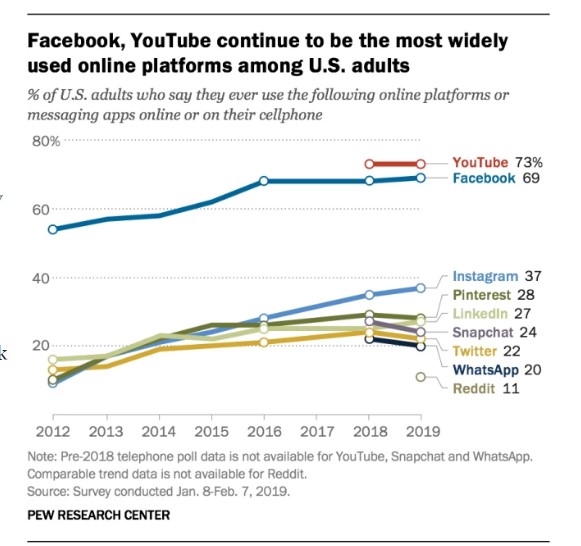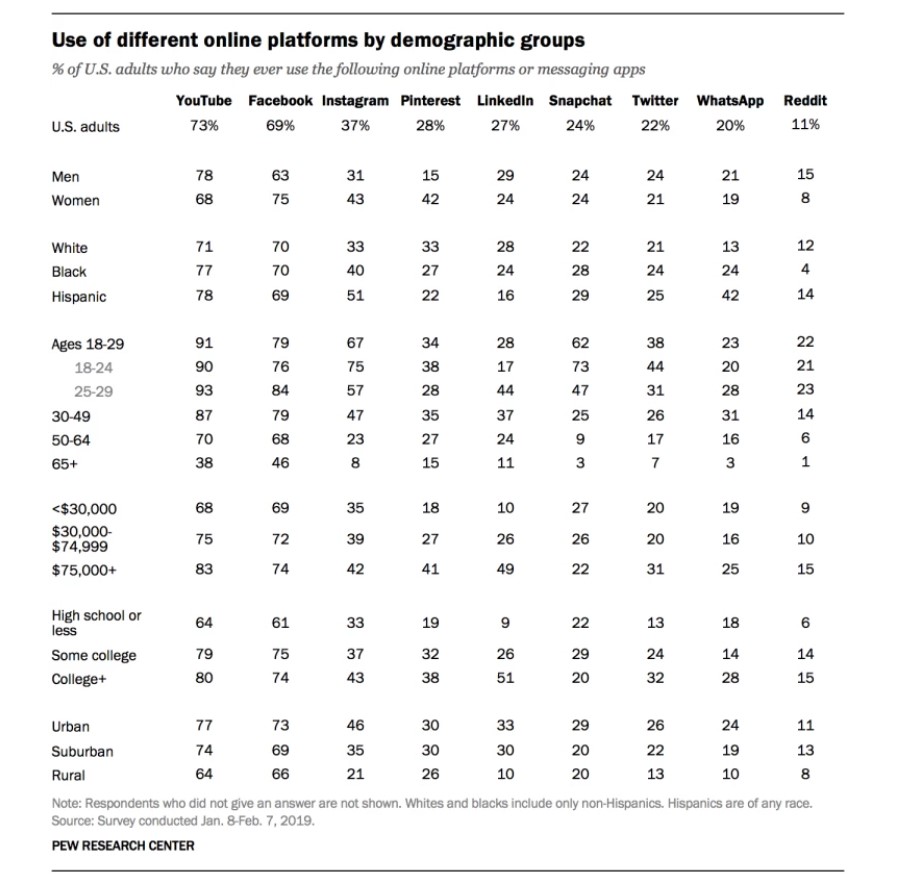

Despite all the negative publicity about social media, a recent Pew Research poll found that “the share of U.S. adults who say they use certain online platforms or apps is statistically unchanged from where it stood in early 2018.”
But the news isn’t all good. The survey also found that the “steady growth” in adult social media use in the US appears to be slowing.
The survey looked at adult use of all major social media platforms, including YouTube, which slightly beats Facebook (73 percent to 69 percent), when it comes to the percentage of U.S. adults who use the service. Facebook-owned Instagram was next at 37 percent, followed by Pinterest (28 percent), LinkedIn (27 percent), Snapchat (24 percent), Twitter (22 percent), Whatsapp (20 percent) and Reddit (11 percent). Facebook also owns Whatsapp, which gives the company three spots among the top nine services.
Social media companies have faced fierce criticism over the past couple of years over such issue as Russian interference, so-called fake news (both real and imagined), harmful content, bullying and mostly unsubstantiated claims of bias against conservatives.
 Age matters when it come to usage. As you might expect, Snapchat (73 percent) and Instagram (75 percent) do well with 18- to 24-year-olds, but so does Facebook, which is used by 79 percent of that age-group. But a lot of older people also use social media. Seven in 10 people between 50 and 64 use YouTube and so do 38 percent of people over 65. Facebook is used by 68 percent of people between 50 and 64 and nearly half (46 percent) of people over 65.
Age matters when it come to usage. As you might expect, Snapchat (73 percent) and Instagram (75 percent) do well with 18- to 24-year-olds, but so does Facebook, which is used by 79 percent of that age-group. But a lot of older people also use social media. Seven in 10 people between 50 and 64 use YouTube and so do 38 percent of people over 65. Facebook is used by 68 percent of people between 50 and 64 and nearly half (46 percent) of people over 65.
Only 3 percent of seniors over 65 use Snapchat while 7 percent of that age group uses Twitter.
Where you live also matters. Urban and suburban dwellers (26 percent) are twice as likely to use Twitter than people in rural areas (13 percent). There’s more than a three-to-one gap for LinkedIn with 33 percent urban vs. 10 percent rural. But YouTube and Facebook usage is relative close among urban and rural dwellers at the rate of 77 percent urban vs. 66 percent rural for YouTube and 73 percent urban vs. 66 percent rural for Facebook.
Daily usage
Perhaps more important than whether one ever uses a service is whether they use it regularly and, despite all the controversies, Facebook users seem to be just as active now as they were in the past. Nearly three-quarters (74 percent) of Facebook users are on the service daily, which is identical to last year. About half (51 percent) say they use it “several times a day.” That compares with 61 percent of Instagram users who say they are on the app at least once a day with 42 percent saying they use it several times daily. Snapchat has similar numbers. Just over half (51 percent) of YouTube users are on the site daily up from 45 percent last year.
I was surprised to see that only 42 percent of Twitter users are on it daily with 25 percent saying they use it several times a day. I tend to think of Twitter as a place that people check into frequently but that may be mostly news junkies and journalist who are glued to the service. Apparently, most Twitter users are far more restrained on how often they check-in.
You can read a lot more about this survey on Pew’s blog.
Regulatory headwinds
The data is mostly good news for Facebook and perhaps one of the reasons why investors continue to value the company, whose stock, despite all the criticism, is outperforming the overall market so far this year. But any optimism about Facebook’s future depends on its ability to solve some of the problems it’s created for itself. Even though attrition has been minimal so far, there is a limit and users could reach a tipping point if Facebook suffers from too many more privacy breaches or horrendous news stories like those following the revelation that the New Zealand shooter used Facebook to live-broadcast his murder of 50 worshippers at a Christchurch mosque. It’s almost a given that foreign-powers will use Facebook to try to influence the 2020 election but we don’t yet know how well the company will be able to thwart those efforts.
Facebook clearly faces additional regulation in the U.S. and around the world. Social media companies are already having to adjust to more stringent privacy rules in Europe now that the General Data Privacy Regulation is in effect and here at home there are legislators on both sides of the aisle anxious to pass laws to rein in Facebook, YouTube and other social media companies. Even Mark Zuckerberg is calling for more regulation. In a Washington Post op-ed on March 30, Zuckerberg called upon governments to play a more active role, arguing that “we need new regulation in four areas: harmful content, election integrity, privacy and data portability.
Whether he truly believes we need more regulation or simply wants to be in a position to influence whatever does get passed, Zuckerberg is smart to at least acknowledge the role of government. Big tech has become too powerful for Washington to ignore. Like energy companies, automakers, big pharma and every other industry that can do harm as well as good, tech needs to be scrutinized by investigative journalists, lawmakers and regulators.
And those of us who have been enthusiastic supporters — myself among them — need to temper our enthusiasm with some healthy skepticism of tech company motives and a deeper understanding of potential dangers to users and society as a whole.
Disclosure: Larry Magid is CEO of ConnectSafely.org, a non-profit internet safety organization that receives financial support from Facebook, Google and other tech companies. He also serves on Facebook’s Safety Advisory Board.
